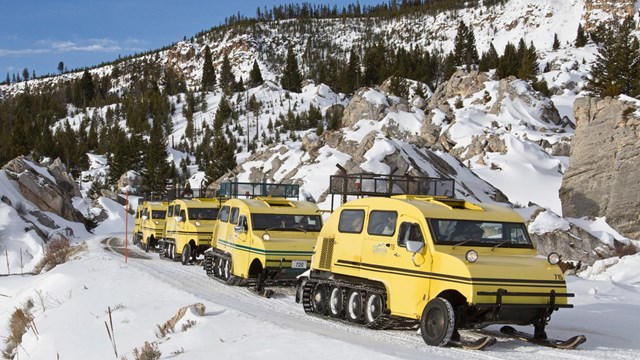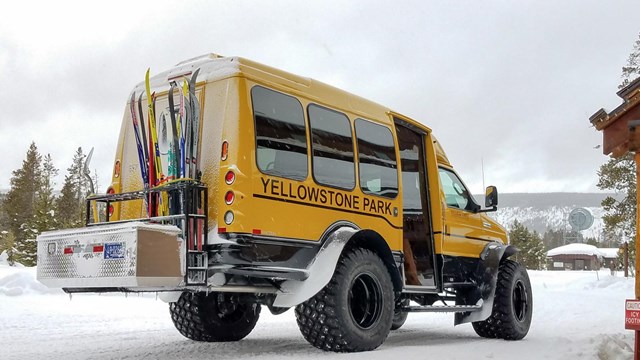
NPS The winter of 1996–1997 was one of the harshest winters of the 1990s, with abundant snow, cold temperatures, and a thick ice layer in the snowpack. Unable to access the forage under the ice, more than 1,000 bison left the park and were shot or shipped to slaughter amid concerns they could transmit brucellosis to cattle in Montana (see chapter 8). Concerned that groomed roads increased the number of bison leaving the park and being killed, the Fund for Animals and other groups filed suit in the US District Court for the District of Columbia against the NPS in May 1997. The groups alleged that the NPS had failed to examine the environmental impacts of winter use. In 1999, the Bluewater Network filed a legal petition with the NPS to ban snowmobiles from all national park units nationwide. These two actions inaugurated more than 15 years of winter use planning and associated lawsuits, and catapulted the issue into one of the NPS’s most visible and enduring environmental controversies. As part of a court mediated settlement, the NPS produced a draft EIS (in 1999) that proposed plowing the road from West Yellowstone to Old Faithful. Public comment did not favor plowing, and unmanaged snowmobile use was deemed to impair park resources. Therefore, park managers opted to ban snowmobiles and allow only snowcoaches in the final EIS published in fall of 2000. At the time, snowmobiles which used new technology to dramatically reduce emissions and somewhat reduce noise (what we now refer to as “Best Available Technology” or BAT) were not widely available commercially. Since that initial EIS, other environmental compliance documents have proposed addressing winter-use impacts using a combination of new technologies, limits on vehicle numbers, mandatory guiding, and monitoring winter-use impacts on park resources. All of these environmental compliance planning documents have proposed allowing a combination of snowmobiles and snowcoaches, with the snowmobile numbers decreasing from plan to plan and snowcoach numbers remaining relatively consistent. By 2002, BAT snowmobiles were commercially available. Requiring visitors to tour with snowmobile guides or in commercially guided snowcoaches reduced the conflicts with wildlife. Resource monitoring allowed the NPS to gauge the effects of these actions and take further protective actions. These changes aimed to eliminate the problems of the past. Each of the subsequent winter use plans was litigated. The Fund for Animals, the Greater Yellowstone Coalition, and other environmental groups consistently sue in the US District Court for the District of Columbia. The International Snowmobile Manufacturer’s Association, the State of Wyoming, the BlueRibbon Coalition, and others consistently file their lawsuits in the US District Court for the District of Wyoming. Litigants have found some traction in each of their courts, with varying degrees of success on any given environmental document. Certainly, the litigation is one of the factors accounting for the ongoing nature of the winter use debate. In each decision against it, the National Park Service has responded by addressing the concerns of the courts. Beginning in 2009, winter use was managed with an interim plan. In 2011, the NPS released a draft Environmental Impact Statement (EIS) for public review on the potential effects of the plan for motorized oversnow travel in the park. Nearly 60,000 comments were filed during a more than 60-day public comment period that followed the draft document’s release. After months of public comment and review, the NPS decided additional study was needed before putting a long-term plan in place and the planning process was extended for another year. Among the subjects identified for further study were requirements for entry into the park by 10:30 am daily, sound and air quality computer modeling assumptions, “best available technology” standards for snowcoaches, the impacts of Sylvan Pass avalanche hazard mitigation, and opportunities for park access by non-commercially guided snowmobile groups. 
History of the Debate
Winter use planning is one of the most contentious issues for park managers and visitors with the debate spanning more than 80 years. 
Winter Use Management Archive
Read the various winter use management and planning documents. 
Winter Use Management
The final Rule authorizing oversnow-vehicle use in Yellowstone was published in the Federal Register on October 23, 2013. |
Last updated: April 18, 2025
